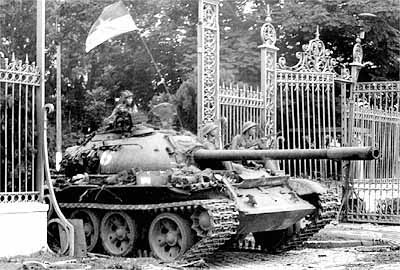(VOVworld) – The Reunification Palace received a large number of visitors during the celebration of the 40th anniversary of southern liberation and national reunification. Here, the visitors learned about the fall of the Saigon regime on April 30, 1975. The Reunification Palace has been recognized as a special national relic for its historical and architectural values.
 |
The Reunification Palace, formerly known as Independence Palace, or Norodom Palace, is located in Nam Ky Khoi Nghia street in Ho Chi Minh city. This building, built by the French between 1868 and 1873 and named for King of Cambodia Norodom I, is surrounded by a large shady park. It was rebuilt in 1962 by order of Ngo Dinh Diem, President of the Saigon regime. It was designed by Ngo Viet Thu, the first Vietnamese architect to have won the Prix de Rome. The building is a perfect blend of modern architecture and traditional oriental architecture. It has the shape of the Chinese character "good luck". Covering an area of 12 hectares, it includes three main floors, two mezzanines, a basement and a terrace.
At 11:30 on April 30, 1975, the flag of the South Vietnam National Liberation Front floated above the roof of the palace. Nguyen Huu Chau, a former staff member of Liberation Radio, recalls:"I was so happy to learn that our soldiers had raised the flag of the National Liberation Front of South Vietnam on the roof of the palace. We must all remember that moment and the great sacrifices of the Vietnamese people”.
The building stills remains as it was 40 years ago. Tanks 843 and 390 of Vietnam People's Army, the first to enter the courtyard of the palace on April 30, 1975, are still there, intact. The People's Artist Thanh Hoa remembers the day she entered the palace with the liberation soldiers:"We sang a lot in the Reunification Palace. Everyone embraced and was happy because the war was over and we could finally find our loved ones”.
 |
In November 1975, the palace hosted the Political Consultative Meeting on the reunification of north and south. After this event, the palace was renamed Reunification Palace. In 1976, the palace was recognized as a special cultural historical relic. The palace receives thousands of tourists every day, said Nguyen Thi Thu Hien of Ho Chi Minh City’s Tourism Promotion Center:"I am proud that Ho Chi Minh City is home to this historic relic. It is a place full of history, a symbol of solidarity and national unity. Through the objects and documents exhibited here, I better understand the struggle of our people 40 years ago".
The historical value and originality of its architecture make the Reunification Palace one of the most interesting sites in Ho Chi Minh City.